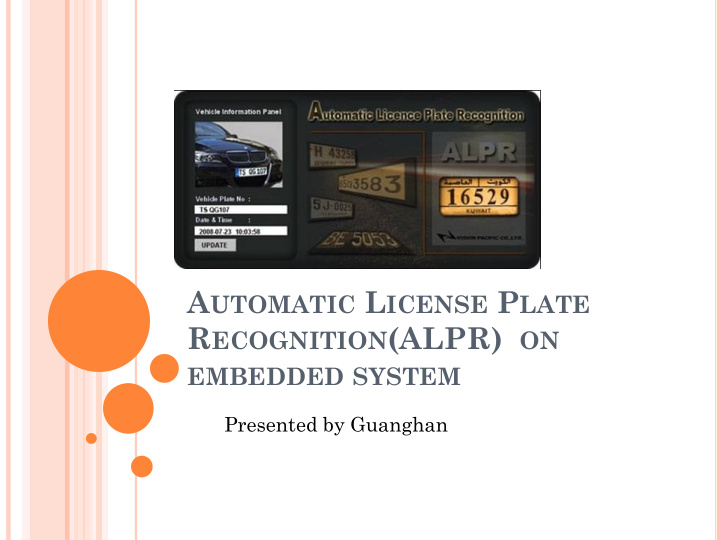



A UTOMATIC L ICENSE P LATE R ECOGNITION (ALPR) ON EMBEDDED SYSTEM Presented by Guanghan
APPLICATIONS 1. Automatic toll collection 2. Traffic law enforcement 3. Parking lot access control 4. Road traffic monitoring
ALPR SYSTEM : SEVERAL STAGES
M Y RESEARCH IN THE REAL - TIME EMBEDDED SYSTEM PROJECT Hardware part:
M Y RESEARCH IN THE REAL - TIME EMBEDDED SYSTEM PROJECT The "main board" performs segmentation on license plate images. Its auxiliary board provides time to capture/load license plate images. "Child boards" need to receive segmented characters from the "main board". The characters are transmitted through ports . The "child boards" will recognize the character received and then send the recognized number back to the "main board" through ports. The "main board" exhibits the recognized numbers.
M Y RESEARCH IN THE REAL - TIME EMBEDDED SYSTEM PROJECT Software part: main board
M Y RESEARCH IN THE REAL - TIME EMBEDDED SYSTEM PROJECT The "main board" side The module for the "main board" will check the B0 button of its auxiliary board. Once B0 button on the auxiliary board of the TS-7250 "main board" is pressed, which simulates the process of this Vehicle retrieval system capturing the image of vehicles, the module will send the message through a fifo to the main thread, who will then read license plates from a pre-defined directory. The main thread will thereafter perform segmentation of the plate. The user space program for the "main board" have three set of threads . Aside from the main thread mentioned above, one set of threads will ask from the main thread for the segmented characters through a shared buffer , then send the segmented characters to "child" boards via the ports. Another set of threads will do the job of receiving recognized numbers from "child boards". Once the numbers are received, the threads send them to the main thread through several named pipes . Once the main thread receives the recognized numbers, since it knows which number comes from which thread, it then prints out the numbers in the same order as they are shown on the plate. Semaphores will be used as a form of synchronization. The main thread only prints out the results after the threads that send the numbers are synchronized.
M Y RESEARCH IN A REAL - TIME EMBEDDED SYSTEM PROJECT Software part: child board
M Y RESEARCH IN A REAL - TIME EMBEDDED SYSTEM PROJECT The "child boards" side There are two threads for the user space program (for each of the child board). For each child board, one thread receives the corresponding character from the "main board", put them in a shared buffer . The other thread reads from the shared buffer the segmented character, perform character recognition, and then send the recognized number back to its corresponding "main board"-thread.
M Y RESEARCH 1. License Plate extraction Scan the whole image. Canny edge detection to find possible regions. Extract HOG features from these possible regions. SVM to classify whether one block contains license plate. K-means to merge nearby possible regions.
M Y RESEARCH 1. License Plate extraction
M Y RESEARCH 1. Licence Plate Extraction Use edge information. Only scan regions with edges. (Cut time half.) Use correlation between scales. Information transfer to the next scale through a size- deformable cascade mask.( Cut another half)
M Y RESEARCH License Plate Extraction Regions that are covered by the scan. Rectangle is plate-size. Will Merge.
MY RESEARCH 1. License Plate Extraction Scan region: Large amount of time is saved. 250ms for two scales.
M Y RESEARCH 2. Alignment Align the four lines of the plate so that the ROI fits the plate contour very well. Use Color information. Align
M Y RESEARCH 2. A LIGNMENT
M Y RESEARCH 2. A LIGNMENT RGB hitogram distance score= dist_RARC- weight_left*dist_RCRB score= dist_RARC- weight_right*dist_RCRB score= dist_RARC- weight_up*dist_RCRB score= dist_RARC- weight_down*dist_RCRB + dist_RARB;
M Y RESEARCH 3. Segmentation Use prior knowledge: Know how many characters exist in a license plate. A corresponding model. Use k-means to binarize the aligned plate. Optimize the score. Scan vertically. In model’s character region if black score adds, in space region if black score decreases.
M Y RESEARCH
M Y RESEARCH 2. SEGMENTATION Scan vertically. 0 to 255 change: ct++ Threshold to binary No threshold
M Y RESEARCH 2. SEGMENTATION Prior Knowledge Segmentation model
M Y RESEARCH 4. Recognition Features: 0 to 1 changes in each column 0 to 1 changes in each row 1 ratio in each column 1 ratio in each row Raw feature Classifier: SVM
M Y RESEARCH R ESULTS : Based on 62 test images. Detection rate: 100% Segmentation: 100% Recognition: 99%
Recommend
More recommend